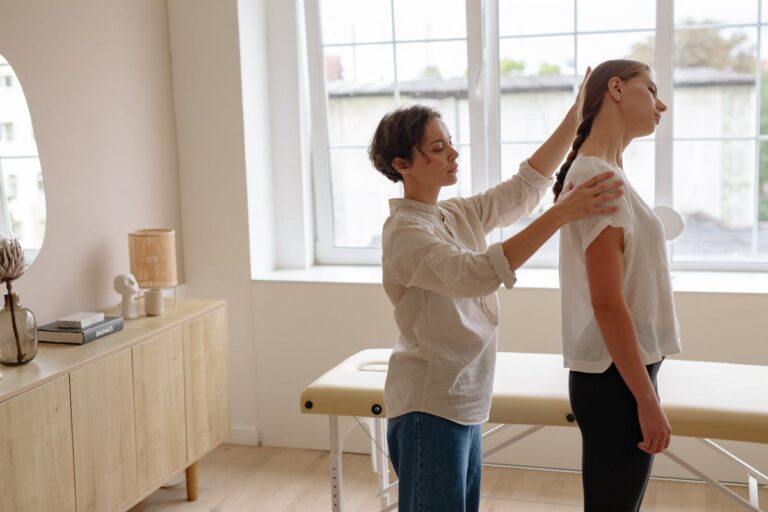The domain of office ergonomics has gained significant recognition in recent times, with chiropractors leading the discussion on its importance. They advocate for various measures, such as neutral wrist positioning, eye-level monitors, and adjustable chairs, all aimed at preventing musculoskeletal disorders. But how exactly do these practices translate into improved comfort, increased productivity, and better health in the long run? Therein lies an intriguing exploration into the critical interplay between our work environments and our well-being.
Understanding the Basics of Ergonomics
While the term “ergonomics” may sound complex, it fundamentally refers to the science of designing and arranging things people use so that the people and things interact most efficiently and safely. This concept is critically applied to workspace design to enhance productivity and reduce injury risk. Understanding ergonomic principles is key to implementing effective workspace solutions. These principles consider human capabilities and limitations, such as body size, strength, speed, sensory abilities (like vision and hearing), and even mental ability. Effective application of these principles in workspace design may involve arranging elements like lighting, desk, and keyboard placement to suit individual needs, reducing strain and discomfort. This fundamental understanding of ergonomics forms the basis for further discussions on specific ergonomic solutions such as adjustable chairs.
Importance of Adjustable Office Chairs
Adjustable office chairs play a pivotal role in promoting proper posture, thereby mitigating the risk of musculoskeletal problems often associated with prolonged sitting. The inherent benefits of adjustability allow users to tailor the chair’s features, such as height and back support, to their specific needs. This can considerably enhance comfort, productivity, and overall well-being in the workplace.
Promoting Proper Posture
Despite conventional wisdom suggesting otherwise, many office workers underestimate the role that adjustable office chairs play in promoting proper posture. Maintaining proper alignment of the spine is essential to reduce the risk of musculoskeletal disorders. Adjustable chairs enable dynamic sitting, a concept that encourages movement while remaining seated. It allows for changes in posture, reducing static load on the spine and facilitating better circulation. Research shows that prolonged static sitting can lead to poor circulation and increased pressure on the spinal discs. Adjustable chairs can aid in achieving the ideal 90-90-90 sitting position (angles at elbows, hips, and knees), a key aspect to proper alignment. As a result, investing in adjustable chairs is a practical approach to foster proper posture, promoting overall well-being.
Benefits of Adjustability
As we explore deeper into the subject, it becomes apparent that the benefits of adjustable office chairs extend beyond mere posture correction. The adjustable features of these chairs enable the creation of customized workspaces, accommodating the unique physical requirements of each individual. This is vital in preventing work-related injuries. Research shows that flexible furniture can considerably reduce the risk of musculoskeletal disorders, which are often caused by prolonged periods of sitting in an incorrect position. In addition, adjustable chairs contribute to increased productivity by enhancing comfort, which subsequently leads to improved focus and efficiency. Therefore, investing in adjustable office chairs is a strategic move towards promoting health, safety, and productivity in the workplace.
Correct Monitor Placement for Eye Health
Proper positioning of your computer monitor plays a significant role in maintaining eye health, an essential yet often overlooked aspect of office ergonomics. Incorrect monitor height can lead to undue strain on the eyes, resulting in eye fatigue, blurred vision, and other ocular issues. To enhance visual comfort and reduce eye strain, the top of the monitor screen should be at or slightly below eye level. This allows the eyes to gaze slightly downward, a more natural and relaxed position. The monitor should also be placed about an arm’s length away, with the screen’s text easily readable without squinting. Remember, optimizing monitor height and placement is a simple, yet effective way to safeguard your eye health in an office environment.

The Role of Good Lighting
The role of good lighting in the office environment is often overlooked, yet it is essential for maintaining productivity and minimizing health risks. Adequate lighting reduces eye strain and prevents headaches, contributing to overall comfort and well-being. Adapting lighting to individual needs and tasks not only enhances visual clarity but also fosters a more conducive workspace.
Importance of Adequate Lighting
Adequate lighting plays a vital role in an ideally ergonomic workspace. It not only contributes to productivity but also greatly impacts the worker’s health and well-being. The lighting color can influence mood and alertness, with cooler colors promoting focus and warmer tones aiding relaxation. Additionally, the lighting quality shapes the workspace ambiance, affecting the visual comfort and reducing the risk of eye strain and fatigue. Research indicates that poor lighting can lead to problems like blurred vision, dry eyes, and headaches, which can hamper work performance. As a result, investing in proper lighting is essential. Achieving ideal lighting involves considering both the task at hand and the individual’s needs, thus fostering a healthier and more productive work environment.
Adjusting Lighting for Comfort
While it’s clear that good lighting is essential for an ergonomic workspace, understanding how to adjust it for comfort is equally significant. The importance of proper lighting cannot be overstated, as it greatly impacts productivity and overall health. Adjusting the color temperature and light intensity are key factors in this process. The color temperature, measured in Kelvin (K), affects the mood and alertness. A warm color temperature (3000K-4000K) can reduce eye strain and create a calming atmosphere. Conversely, a cooler color temperature (5000K-6500K) can stimulate alertness. Light intensity, measured in lumens, should be adjustable to cater to specific tasks and personal comfort. Remember, overly bright or dim lighting can cause discomfort and negatively affect productivity.
Importance of Regular Breaks and Movement
Despite the widespread belief that prolonged focus increases productivity, research suggests otherwise. Prolonged sitting can lead to musculoskeletal problems and decreased productivity. Chiropractors highly recommend regular movement breaks during work hours. These breaks not only help in relieving physical strain but also improve mental acuity.
Research indicates that movement breaks, taken every 30 minutes, can markedly reduce the risk of developing musculoskeletal disorders. During these breaks, simple stretching exercises targeting the neck, back, and wrist can be particularly beneficial. These stretches help to maintain flexibility, relieve muscle tension and promote better blood circulation.
Optimal Keyboard and Mouse Positioning
Proper positioning of keyboard and mouse is a vital aspect of office ergonomics that can greatly reduce the risk of repetitive strain injuries. Ideal keyboard height is typically at elbow level, allowing the user’s arms to gently rest while typing, thereby preventing excessive strain on the wrists and forearms. The mouse should be placed directly next to the keyboard, eliminating the need for overreach. The mouse angle is essential as well; it should be held in a natural, comfortable position, promoting neutral wrist posture. Further, both the keyboard and mouse should be directly in front of the user to avoid twisting of the spine. Adhering to these principles can mitigate the occurrence of musculoskeletal disorders stemming from prolonged computer usage.
Practicing Correct Posture at Work
A considerable majority of office workers spend their days seated at desks, making the practice of correct posture an essential component of office ergonomics. The first step towards posture correction is understanding the proper alignment of the body. Ideally, the back should be straight, the shoulders relaxed, and the feet flat on the floor. Prolonged sitting can lead to muscle tension and fatigue. As a result, integrating workplace stretches into your routine is highly recommended. Simple movements like neck rotation, shoulder shrugs, and wrist stretches can alleviate tension. Studies also suggest the use of visual cues or reminders to maintain correct posture. To sum up, practicing correct posture combined with regular stretches can greatly improve overall comfort and productivity at work.
Benefits of Ergonomic Tools and Accessories
Investing in ergonomic tools and accessories can greatly enhance the work experience for office employees. Ergonomic innovations not only contribute to a comfortable workspace but also play a pivotal role in productivity enhancement. Studies indicate that tools such as adjustable chairs, standing desks, and ergonomically-designed keyboards and mice reduce the strain on the body, leading to decreased fatigue and discomfort. This reduction in physical strain allows employees to focus better on their tasks, improving both efficiency and output quality. Moreover, these accessories can potentially minimize the risk of developing musculoskeletal disorders over a prolonged period of office work. Consequently, integrating ergonomic tools and accessories into the workspace is a worthwhile investment for long-term employee well-being and productivity.
Frequently Asked Questions
What Specific Exercises Can I Do to Avoid Work-Related Musculoskeletal Disorders?
Incorporating daily stretching routines and strengthening exercises can mitigate work-related musculoskeletal disorders. These may include neck stretches, wrist flexes, and core exercises to enhance posture and alleviate strain on your body during prolonged periods of sitting.
How Does Temperature and Humidity Affect My Comfort in the Office?
Temperature and humidity greatly impact comfort levels in an office environment. High temperatures can cause discomfort and decreased productivity, while low humidity may lead to dry skin and eye irritation, affecting overall work performance.
What Are the Recommended Laptops or Computer Brands for Ergonomic Use?
Ergonomic use is not necessarily linked to specific laptop brands. It’s more about how you use your device. However, brands offering adjustable, backlit keyboards and anti-glare screens can enhance comfort. Consider ergonomic accessories for ideal setup.
Are There Specific Ergonomic Considerations for People Who Wear Glasses?
Yes, individuals who wear glasses should consider lens positioning and screen glare. Proper positioning reduces neck strain, while minimizing screen glare can decrease eye strain—both vital ergonomic considerations for glasses wearers.
How Can I Ergonomically Set up My Home Office?
Setting up a home office ergonomically involves careful desk height and chair selection. The desk should align with your elbows when seated, and the chair should support your lower back and promote an upright posture.






